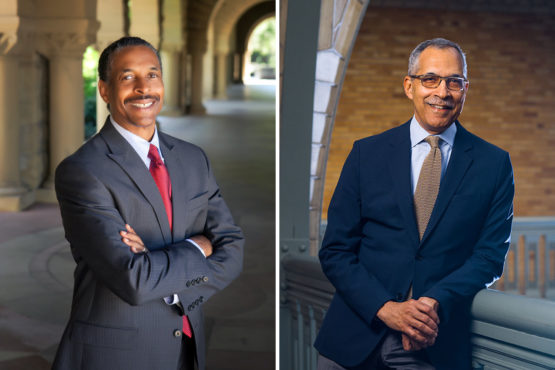Stanford President Tessier-Lavigne appoints co-chairs of Community Board on Public Safety
President Marc Tessier-Lavigne has appointed Patrick H. Dunkley, deputy athletic director, and Claude M. Steele, a professor emeritus of psychology, as co-chairs of the Community Board on Public Safety, which is expected to hold its first meeting in early fall quarter.
President Marc Tessier-Lavigne has appointed the co-chairs of the Community Board on Public Safety, which is charged with assessing the needs and concerns of the community related to policing (including community safety and equity of experience among students, faculty and staff), as well as fostering communication and trust between Stanford’s Department of Public Safety and the broader university community.

Patrick Dunkley, left, and Claude Steele. (Image credit: Courtesy Patrick Dunkley and Claude Steele)
Tessier-Lavigne on Thursday said he has appointed Patrick H. Dunkley, deputy athletic director in Stanford Athletics, and Claude M. Steele, the Lucie Stern Professor Emeritus of Psychology in the School of Humanities and Sciences, as co-chairs of the new board.
When Tessier-Lavigne announced the establishment of the board in June, he said Stanford is committed to maintaining a healthy and safe environment in which all community members can thrive, and are able to live without fear of racism, discrimination, harassment and violence. As part of that commitment, he said the university must ensure that its public safety policies and practices are consistent with the university’s mission and values.
Since that time, Tessier-Lavigne and Provost Persis Drell have met with student leaders and with chief Laura Wilson, leader of the Department of Public Safety, who have provided input on the charge and composition to the board.
The board will identify issues of safety, make recommendations and provide an avenue for regular community feedback.
“I am delighted that our Community Board on Public Safety will benefit from the deep experience and thoughtful leadership of Claude Steele and Patrick Dunkley, and I am grateful to each of them for extending this important service to our community,” Tessier-Lavigne said.
“This board will provide an important new avenue for feedback and engagement on public safety issues at Stanford. We look forward to it being a place where concerns that are important to members of our community can be aired, and where recommendations can be made to university leadership. We are fortunate to have a Department of Public Safety and a chief – and Stanford alum – Laura Wilson, who are committed to providing trusted and professional service to our community, and who are eager to be in continued conversation with our community about these issues.”
Steele is an internationally recognized expert on the subject of stereotype threat and its application to minority student academic performance and intergroup relations. His former roles include chair of the Department of Psychology, dean of the Stanford Graduate School of Education, and provost at Columbia University and the University of California, Berkeley.
“How public safety is maintained on campus is a critical driver of how inclusive our campus feels to its broad diversity of students,” Steele said. “This committee is part of an ongoing effort – ever seeking improvement – to assure that Stanford’s public safety mission facilitates its mission of inclusiveness.”
Dunkley has served Stanford for more than 18 years in a variety of leadership roles working with faculty, staff and students, and brings broad expertise in human resources, legal affairs, compliance and risk management, among other subjects.
Dunkley thanked Tessier-Lavigne for entrusting him with the responsibility of co-chairing the board.
“I have such tremendous passion for Stanford University and the health and safety of its students, staff and faculty,” Dunkley said. “I am eager to play a role in supporting the fundamental and vital interests acknowledged by the president. I applaud the structure, which includes broad representation on the board from across the Stanford community. Such involvement is essential to our success.”
In addition to co-chairs Dunkley and Steele, the board will include three faculty members, two undergraduate students and two graduate students, three staff members, three community members, and three members of Stanford’s Department of Public Safety.
Three board members have already been appointed by virtue of their positions: Munira Alimire, ’22, president of the Associated Students of Stanford University; Marc E. Jones, JD ’82 (BA ’79), a member of Stanford’s Board of Trustees; and C. Matthew Snipp, vice provost for faculty diversity and engagement, and the Burnet C. and Mildred Finley Wohlford Professor in the School of Humanities and Sciences.
Dunkley and Steele will appoint the remaining members of the board, which is expected to hold its first meeting in fall quarter. The co-chairs will work with the ASSU Nominations Committee to seek student nominations. Additional nominations or comments regarding the board may be sent to publicsafetycommunityboard@stanford.edu.
Wilson said she has long wanted Stanford and Stanford DPS to be a model for how public safety is provided and achieved in a campus community – even if that meant breaking with past practices and ideas about how to best provide a safe, secure atmosphere conducive to freedom of expression and movement for people and their property.
“With community engagement and commitment, I have renewed hope that the Stanford community – of which Stanford DPS is a part – can work together to create an environment in which each individual can feel safe, valued and appreciated. The Stanford DPS team is pleased that President Tessier-Lavigne has established a university structure to facilitate community engagement in achieving this vision.”
